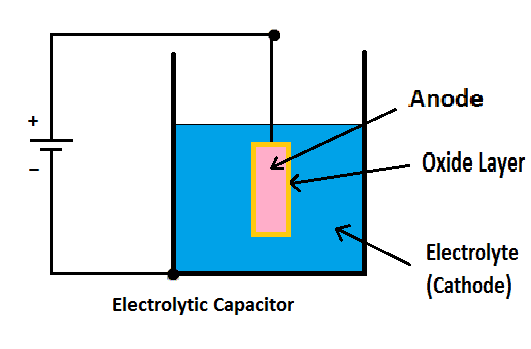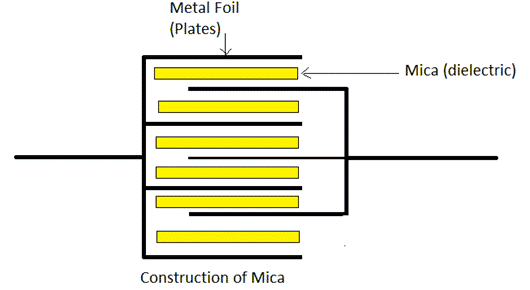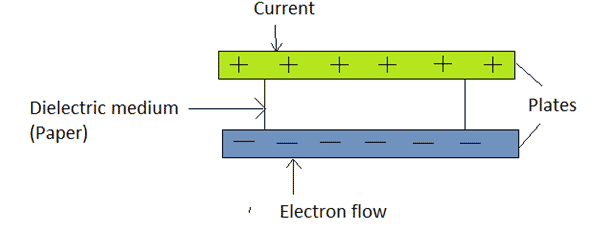In this article, we will discuss the different types of capacitors & their applications. The capacitor is a very important electrical component, and it is widely used in electrical and electronic circuits.
What is a capacitor?
The capacitor is an electrical component that stores electric charge. The Capacitor has one or more pairs of conductors and a dielectric medium separates these pairs of conducting plates. A dielectric medium is an electrically insulating material between the plates of the capacitor. The capacitor is a passive element with two terminals.
The voltage across a capacitor is ;

Where,
Q is the amount of charge stored on each plate, and C is the capacitance.
The two forms of the I-V (Current-Voltage) relationship for the capacitor are as below:

Capacitors have many important applications. They are:
- In digital circuits to retain information stored in large computer/laptops/controllers memories during power failure.
- Capacitors act as filters to divert spurious electric signals and hence prevent damage to sensitive components and circuits caused by electric surges.
Different Types of Capacitors
Electrolytic capacitors
Electrolytic capacitors fall in the category of polarized capacitors which have a positive and a negative plate. The positive metal plate act as an anode. Due to anodization, an insulating oxide layer acts as a dielectric.

The solid, liquid, or gel electrolyte forms a layer on the oxide layer. The negative plate act as a cathode. They have much higher capacitance-voltage per unit volume as compared to ceramic or film capacitors.
Mica capacitors

The Mica capacitor has mica as its dielectric material. Mica is a silicate mineral, generally found in rocks, granite, etc. Mica is the best choice as an electrical insulator. It has a low capacitance range from 20pF – 10pF. The capacitance of the mica capacitors does not change over a period of time. Thus, they provide stable capacitance.
Paper capacitors

Paper capacitors are capacitor that uses paper as a dielectric medium that stores energy in form of an electrical field. They have a positive plate and a negative plate. They are most suitable for power lines where the capacitance value is 1 nF to 1uF.
Film capacitors
Film capacitors have insulating plastic film as dielectric. It is sometimes combined with paper as a carrier of the electrodes. The electrodes may be made of metalized aluminum or zinc applied directly to the surface of the plastic film, or a separate metallic foil. Two of these conductive layers are wound into a cylinder-shaped winding which is usually flattened to reduce mounting space requirements on a printed circuit board, or layered as multiple single layers stacked together, to form a capacitor body.
Non-polarized capacitors
A non-polarized capacitor is a type of capacitor that has no polarity and hence it is possible to connect the capacitor either way in any given circuit. They have wide application in circuits of coupling, decoupling, feedback, compensation, and oscillation. They are most suitable for use in pure AC circuits. Also, non-polarized capacitors find their application for high-frequency filtering due to their modest capacitance. Different types of non-polarized capacitors are:
- Ceramic capacitors
- Polyester Capacitors
- Polystyrene Capacitors
- Polycarbonate Capacitors
- Polypropylene Capacitors
- Teflon Capacitors
- Glass Capacitors
Ceramic capacitors
The ceramic capacitors are fixed-value capacitors that have ceramic material as a dielectric and a metal layer as a dielectric. There are two classes of ceramic capacitors.
- Class 1 ceramic capacitors are best suited for resonant circuit applications because it offers high stability and low losses.
- Class 2 ceramic capacitors offer high volumetric efficiency for buffer, coupling, and by-pass applications.
Applications of Capacitors
The main applications of capacitors are:
- Energy storage
- Power conditioner in power conditioning circuits
- High pass and low pass filters
- Power rail filtering
- Motor starters
- Signal processing
What are the hazards while dealing with capacitors?
- Capacitors may remain charged long after switching off the power supply to the circuit; this stored charge is dangerous and may cause potentially dangerous shocks or damage to connected devices.
- High-voltage capacitors may fail catastrophically when they are under voltage or currents above their limits, or as they reach their normal life expectancy.
- Failure of dielectric or metal contact may cause dielectric fluid formation, leading to an explosion, cracking, or even explosion. Capacitors used in RF or continuous current systems can be extremely hot, especially during the area of capacitor rolls.
- Capacitors used within large power banks can explode violently when a single capacitor causes a loss of energy stored throughout the bank in a failing unit.
nice